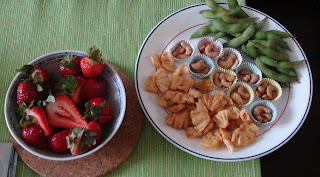Last Sunday I hosted a Sunday Afternoon Tea event, focusing on green tea. It was a great way to share with my friends a little bit about green tea and have afternoon tea.
I showcased 5 green teas. As you can see, I used a glass tea pot to showcase the tea leaves while they brewed. To brew green tea, the most important thing to remember is to use water that is around 70-80 degrees Celcius or 160 - 175 degrees Fahrenheit. There are some green teas that may be best brewed outside this range but this is a general range for most. If you don't have a thermometer, I usually let the water sit for 4-5 mins, pour it into another vessel before pouring onto the tea, or adding a little bit of cold water to the tea leaves before pouring in the water.
So, onto the teas!
Tea #1: Japanese Sencha

Tea #2: Chinese Longjing Dragonwell
Longjing or dragonwell green tea is a famous Chinese tea and was once known as a "tribute" tea, specially made for the imperial palace. Today it can be enjoyed by many. My friends thought it was quite interesting how the shape was flat and that it is made by pan-frying on a wok by hand. This is what I especially appreciate about this tea, that there is a level of skill required to processing this tea and that it is hand-processed, requiring a sensory knowledge to achieve the final product. The tea gives a vegetal yet slightly buttery taste which is nice.
 weighing out 3g of tea (my pot was just under a cup in volume)
weighing out 3g of tea (my pot was just under a cup in volume)
I had some fresh strawberries, dried pineapple slices, cashews, and salted edamame as snacks that might go well with the tea. Cashews went well with the tea and unfortunately I should have realized to provide a little more tea for my friends so they can sample more of the pairings!
 Tea #3: Japanese Gyokuro
Tea #3: Japanese Gyokuro
My friend had given me some dark emerald green Gyokuro tea. This tea is special in that it is grown under shade, possibly 14-30 days before harvesting. This results in a larger number of chlorophyll production by the leaves and thus a unique flavour profile. This tea tastes grassy and has strong notes of seaweed flavour to it.
 To go with this tea, I made some tuna, fish roe, and cucumber sandwich rolls. I must say that I found the bread to be a little on the moist side. When making sandwiches I would recommend letting the bread dry out more before making.
To go with this tea, I made some tuna, fish roe, and cucumber sandwich rolls. I must say that I found the bread to be a little on the moist side. When making sandwiches I would recommend letting the bread dry out more before making.

Tea #4: Jasmine Tea Shaped into a Star
These tea leaves are wrapped by hand into a star shape with large buds. A beautiful jasmine aroma as expected was enjoyed; the taste was light, sweet and delicious. Traditionally, jasmine flowers are used to scent the leaves, done in multiple layers and over a series of drying periods. As the leaves dry, it picks up the aroma of the jasmine flower. High quality jasmine tea undergoes this lengthy processing and thus it is unlikely to find much of this kind due to the effort that goes into making this tea. In most cases, you won't see actual jasmine petals mixed in with the tea leaves because all the aroma has already gone into the leaves.
Tea #5: Chinese Xin Yang Mao Jian "Hairy Tips" Green Tea
These tea leaves were very fine needle-like dark green leaves. If you look closely, you can see the small "hairy" white tips of the buds. The dry leaves had a strong aroma, somewhat salty and seaweed like. However, when brewed this tea had quite a strong vegetal taste to it, some bitterness to the tea also was apparent, but there was a lingering aftertaste. The liquor was also a cloudy yellow-green colour - similar to Sencha in the cloudiness but unlike the bright green of Sencha, it was duller.


Chestnut cream tart

Dark chocolate tart (on the right)

So, some additional notes about having a tea tasting that I think worked well:
1. Offer 5 different teas. I found this to be a good number that also gives a good variety without overwhelming.
2. Re-steep the tea or increase volume of tea made to allow your friends to have at 2-3 small cups of tea or one regular sized tea cup. Especially when food is served. This also allows for examining the taste of the teas more.
3. If offering food, offer savory and sweet snacks - 5 different snacks is also a good number.
4. Showing the leaf before and after the steep was appreciated.
5. If doing a tea tasting for those that are unfamiliar with tea, providing helpful hints on how to make the tea (especially loose leaf teas) is important.
6. Most importantly, enjoy the experience!!





No comments:
Post a Comment